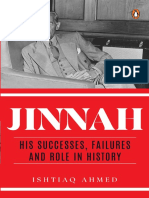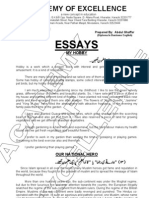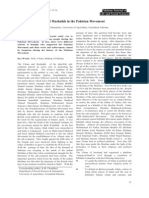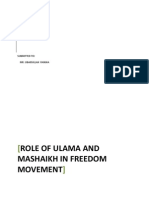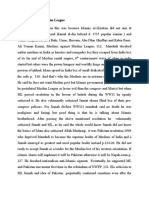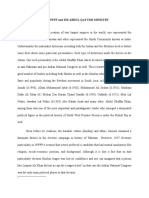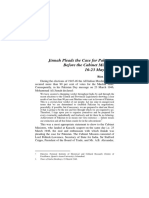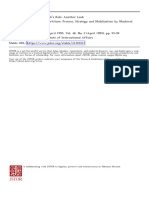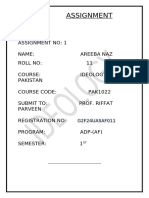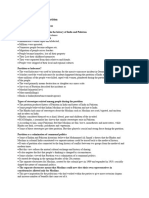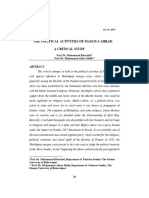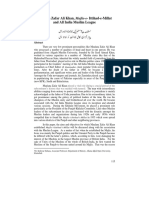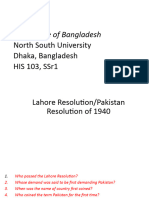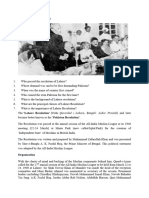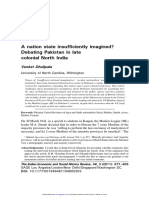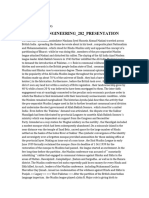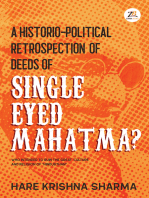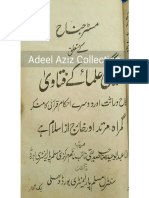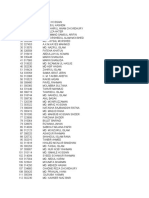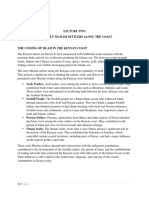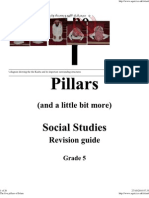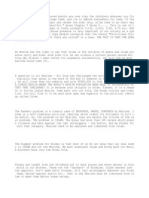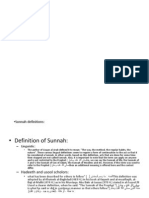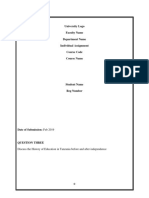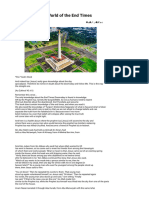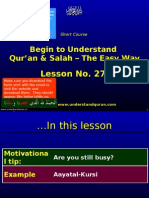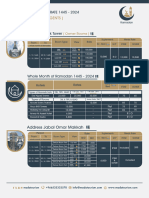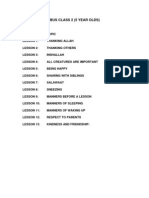V4i2 8
V4i2 8
Uploaded by
Mohammad AliCopyright:
Available Formats
V4i2 8
V4i2 8
Uploaded by
Mohammad AliOriginal Title
Copyright
Available Formats
Share this document
Did you find this document useful?
Is this content inappropriate?
Copyright:
Available Formats
V4i2 8
V4i2 8
Uploaded by
Mohammad AliCopyright:
Available Formats
Quaid-e-Azam and Pir Amn-ul-Hasanat of Manki Sharif Abasyn Journal of Social Sciences. Vol.4 No.
Quaid-e-Azam Muhammad Ali Jinnah and Pir Amin-ul-
Hasanat of Manki Sharif
Israj Khan1
Toheeda Begum2
The North West Frontier Province (now Khyber Pakhtunkhwa) has
a unique place in the history of Pakistan Movement. In the beginning of
the twentieth century marked the inclusion of political realization in the
frontier. Some educated young blood took its first formal manifestation
in 1912 and the formation of Provincial Muslim League took place at
Peshawar (Khattak, 1998, January-June-3). The people of frontier shared
the angst and annoyance of the other provinces and vigorously
participated in Kilafat and Hijrat and non-cooperation movements
earnestly. The official record of the British and Indian Government are
occupied of stories of their anguish (Shah, 1990). The year of 1929, saw
the configuration of the Khudai Khidmatgar (God Servant) by Khan
Abdul Ghaffar Khan, which was to resolve the course of the frontier
politics for the residual of the first half of the 20th century (Shah, 2008,
January).
In 1901, viceroy of India Lord G. N Curzon alienated five distracts
Peshawar, Kohat, Bannu, D.I Khan and Hazara from Punjab and
amalgamated with five political Agencies (Khattak, 1998, January-June).
In April 1932, the frontier Province became a Governor Province. The
1
.Research Scholar MPhil Pakistan studies, Department of Pakistan Studies,
ICP
2
. Lecturer Pakistan Studies in Frontier Women University, Peshawar
Israj Khan & Toheeda 397
Quaid-e-Azam and Pir Amn-ul-Hasanat of Manki Sharif Abasyn Journal of Social Sciences. Vol.4 No.2
viceroy of India Lord Willington (1932-1936) personally visited
Peshawar and Sir Ralph Griffith as a first Governor of the province was
announced (Ali, 2009). After the first Provincial election under the
Government of India Act 1935, Sir Abdul Qayum Khan was able to form
a coalition government but some months later he was succeeded by Dr.
Khan Sahib, brother of Abdul Ghaffar Khan (Sayeed, 1980)..
The NWFP (Khyber Pakhtunkhwa) was a Muslim majority
Province but the frontier Congress was dominant there and the Provincial
Muslim League had no role in the political affairs. A sever set back to
the League, when Jinnah visited the frontier on October 1936, but he
failed to make his mark (Khattak, 1998, January-June). In 1943, Sardar
Aurangzeb Khan formed a coalition government which made feasible by
the Congress pronouncement to resign ministries as a protest against
India’s participation in the Word War-II. But the League government
was soon dislodged by the Congress as it was not strong enough and Dr.
Khan Sahib once again formed government in the province. Then a
question arises, who played a predominant role, without who the Muslim
League would not have been able to win the plebiscite in frontier? Their
was no uncertainty that religious leader like the Pir of Manki Sharif with
his followers of more than two millions could take recognition for having
injection into the Muslim League a new spiritual and political passion
(Sayeed, 1980). An effort has been made to reinvigorate the facts and a
tender attempt with a new language.
Muhammad Amin-ul-Hasanat bin Abdur Rauf known as 'Pir Sahib
of Manki Sharif’2 and Fateh Referendum who born in 1922 a notorious
Muhammad Amin-ul-Hasanat known as Pir Sahib of Manki Sharifwas the son
the of Abdur Rauf son the of Abdul Haq son the of Abdul Wahab son the of
Zia-uddin son the of Muhammad Yusaf son the of Yaseen Khan son the of
Israj Khan & Toheeda 398
Quaid-e-Azam and Pir Amn-ul-Hasanat of Manki Sharif Abasyn Journal of Social Sciences. Vol.4 No.2
saintly religious family six years before the Nehru Report and the death
of his grandfather Abdul Haq Thani (Second). In 38 years of short life he
had great recognition in the Sub-continent in spiritual, religious, socio-
political arena. He inherited a large number of followers and his
influence was particularly strong in the Pakhtun-belt spread all over the
frontier Province (Shah, 1990).
Quaid-e-Azam Muhammad Ali Jinnah once went to Saydan-Pur
(Sirinagar) to meet Pir Syed Jama’at Ali Shah who knew about the
potentialities of Pir of Manki. He advised Muhammad Ali Jinnah to meet
Pir of Manki Sharif (Hazarvi, 1980 as cited Zaman, 1984-87) because in
his opinion he was the only religious personality in the frontier Province
who could help him to counter the Abdul Ghaffar Khan (Bach Khan)
political dominance (Jonson, 1981). Jinnah adopted a very effective
strategy to counter Frontier Congress and Abdul Hamid Badayuni to
Sardar Abdur Rab Nishtar asking him to apprise the Pir of Manki Sharif
of the actual situation. Nishtar at once conveyed Jinnah message to Pir
Amin-ul-Hasanat of Manki Sharif and told him that the frontier Muslims
were in need of his valuable services (Zaman, 86) Besides, after the
failure of Simla Conference like other Muslim Pir Sahib also convinced
that Hindu-Muslim unity in the subcontinent is impracticable and he
realized the fact that the Ulema and Mashaikh should now supported the
Muslim League (Shah, 1990). Some days later Pir sahib called his trusted
Mashaikh like Syed Abdullah Shah of Hazara, Maulana Masleh-ud-din,
Zaini son the of Bathi son the of Ano son the of Barkwiat son the of Tori son
the of Turman son the of Karlan son the of Muhammad Rajjal son the of
Muhammad Khadim son the of Muhammad Ismail son the of Muhammad
Jaafar son the of Muhammad Baqir son the of Imam Zainul Abidin son the of
Imam Hussain son the of Hazrat Ali R.A (Zaman, 1987).
Israj Khan & Toheeda 399
Quaid-e-Azam and Pir Amn-ul-Hasanat of Manki Sharif Abasyn Journal of Social Sciences. Vol.4 No.2
Maulana Shaista Gul (Mathy Maulana Sahib) etc. at Manki Sharif and
discussed the Jinnah massage and local political matter with them
thoroughly and said:-
“My family and all the followers have connected the
frontier Congress. If I come out of my cloister of
worship and contend against the congress in the political
conflict all of them will quit the Congress. Follow me
and accordingly the frontier Province will become a part
of Pakistan”. (Hasanat, n.d as cited by Zaman, 1984-
1986).
Consequently, all the trusted Mashaikh articulated their trust in Pir
Sahib and it was decided to hold a conference of the Ulemas, Pirs and
Mashaikh. For this purpose Pir sahib sent a delegation who toured to
every nook and corner of India consisted on Maulana Shaista Gul and
Maulana Masleh-ud-din. According to Mir Ahmad on 13th October,
1945 five hundred Ulemas, Pirs and Mashaikh participated the three days
Ulemas and Mashaikh Conference at Pir Manki Sharif. Notable amongst
them were Syed Jama’at Ali shah3, Maulana Shabir Ahmad Usmani,
Abdul Hamid Badayuni, Naeem-ud-din Muradabadi, Maulana Shaista
Gul, Pir abdul latif of Zakori Sharif, Maulana Abdul Sattar Niazi,
Maulana Masleh-ud-din, Faqir Abdul Wasih of Bannu, Maulana Hazrat
Gul of Dosehra, Pir of Tunsa Sharif, Maulana Badshah Gul of Akora
3
Pir Syed Jama’at Ali Shah (1840–1951) known as Amir-e-Millat was a Syed
and a great spiritual leader of the Alipur Sharif (Punjab). He was a big
enthusiast of the Pakistan movement. he had numerous correspondence
to Quaid-e-Azam offering suggestion and support and he was influential in
getting the laypeople to vote for the Muslim League: he issued a fatwa saying
that he would not read the funeral prayer of anyone of his cohorts who did not
cast his vote for Pakistan. It is said that due his persuasion Pir Sahib of Manki
Sharif entered into politics and supported Jinnah and his Muslim League.
Israj Khan & Toheeda 400
Quaid-e-Azam and Pir Amn-ul-Hasanat of Manki Sharif Abasyn Journal of Social Sciences. Vol.4 No.2
Khattak etc (Ahmad.1987). On the second day of the conference on 14th
October in his speech Pir Sahib said
“The aim of this gathering is to comprehend that on the
one hand we have to get liberate of the British and on the
other to get rid of Hindu’s Government by opposing the
Congress. Currently Muslim League headed by Jinnah is
the only political party which can effectively oppose the
Congress. So unity among the Muslim is the greatest need
of the day. Every Muslim should struggle for the creation
of Pakistan where they could live with honour and self-
esteem. So there is no other substitute, except to join the
Muslim League, because is the only party struggling for
the glory of Islam and dignity of the Muslim” (Hasanat,
1945 as cited Shah, p. 20).
The conference recommended the formation of a party known as
Jamiat-ul-Asifa. So Pir Jama’at Ali shah was elected its president and Pir
Sahib of Golrah Sharif its Vice president while Pir Sahib of Manki Sharif
became its convener (Shah, 1990). The aim of this party was to underpin
the demand for the establishment of Pakistan to the principles of the
Quran and Sunnah. So Pir of Manki Sharif determined to support the
Muslim League on the condition that Sharia (Islamic Law) would be
enforced in Pakistan as the law of the land (Khan, 2011, July 28, Zaman,
1984-86). Throughout the country, the Ulemas and Mashaikh encouraged
the aim and objectives of Jamiat-ul-Asifa by sending letters of
appreciation (Shah, 1990). During that time a literary communication
was started between Pir of Manki Sharif and Muhammad Ali Jinnah. On
November 18, 1945 Pir Sahib sent one of his closed associate named
Qazi Abdul Hakim Khattak to Quaid-e-Azam to apprise him of his
decision (Amin, 2011, July 28). Jinnah responded quickly by sending a
letter on November 18, 1945 as:
Israj Khan & Toheeda 401
Quaid-e-Azam and Pir Amn-ul-Hasanat of Manki Sharif Abasyn Journal of Social Sciences. Vol.4 No.2
“...I am greatly thankful you for the powerful support
which you have been pleased to give to the All India
Muslim League….as regards your preliminary question of
Pakistan being established in settled, it will not be the
Muslim League that will frame the constitution of
Pakistan but inhabitants of Pakistan in which 75% will be
the Musalmans and therefore you will understand that it
will be a Muslim government and it will be for the people
of Pakistan to frame the constitution under which the
Pakistan government will come into being and function.
Therefore, there need be no apprehension that the
Constitution Making Body which will composed of
overwhelming majority of Muslims can be ever establish
any constitution for Pakistan other than one based on
Islamic ideals, nor can the government of Pakistan when
comes into being act contrary to Islamic ideals and
principles”(Jinnah, 1945, November 18).
Muhammad Ali Jinnah promised in this letter that he would to
meet with Pir Sahib personally while coming to Peshawar in order to
attend the frontier conference of the League scheduled on November 20,
1945. After the arrival of Quaid-e-Azam in Peshawar, 4 Pir Sahib invited
him to Manki Sharif to which he agreed in these words:
“I am going to Mardan on 24th November, and on my way
I shall be glad to go to Manki Sharif. I propose to start
from here at 11:00 am and break my journey and spend
at least half-an-hour with you and have the pleasure of
meeting you” (Jinnah, 1945, November 20).
On November 24, 1945, consequently, Muhammad Ali Jinnah
went to Pir of Manki Sharif along with Liaqat Ali Khan, Sardar Abdur
Rab Nishtar and Abdul Qayum Khan, Khan Samin Khan, Mian
Muhammad Shah of Pabbi, Fida Muhammad Khan and other prominent
Provincial League members on the proposed date and time (Gul, 1986,
March 10). Jinnah was passionately welcomed by Pir Sahib, some
Israj Khan & Toheeda 402
Quaid-e-Azam and Pir Amn-ul-Hasanat of Manki Sharif Abasyn Journal of Social Sciences. Vol.4 No.2
prominent Ulemas from all over India, large number cohorts of Pir Sahib
and other people of the province who were standing both sides on the
road and decorated the six kilometer distance from Nowshera to Pir
Manki Sharif with Green flags and streamers and chanting the slogans
Allah-o-Akber, Quaid-e-Azam Zindabad, Pir Manki Sharif Zindabad
(Ahmad, 1987). On the way to Pir Manki Sharif Jinnah said to Sardar
Abdur Rab Nishtar who accompanied with him in his car “I do not be
acquainted with, whether Pakistan will establish during my life or not but
now I see, that the demand for Pakistan has became the final providence
of the Muslim and if not today then within ten years. I can see the
Muslims glorious future and they will achieve Pakistan. Now, I am going
to die like a happy and successful person” (Nishtar, n.d). Jinnah was
happy to saw the comeback of Pir Sahib. He reached there at 11:45 am to
Pir Manki Sharif. Jinnah and other League leaders were then conducted
to a Hall where the Ulemas and Mashaikh were waiting for them. Main
Abdul Karim one the follower of Pir Sahib placed the draft of an accord
before Jinnah for approval (Shah, 1990). On the following terms and
conditions in the provincial Legislative Assembly on which agreed by
the Jinnah and Ulemas and Mashaikh were:
Every law in Pakistan will be in consistency with Islamic Sharia
and not repugnant to Quran and Sunnah.
Each Bill which concern with Islamic Sharia will be presented to
the President of Jamiat-ul-Asifa to check, only after the
endorsement by its President will present the Bill to the
constituent Assembly for further proceedings.
Israj Khan & Toheeda 403
Quaid-e-Azam and Pir Amn-ul-Hasanat of Manki Sharif Abasyn Journal of Social Sciences. Vol.4 No.2
Member of the Muslim League will present each and every
stipulate of the Jamiat-ul-Asifa in the Assembly and will try for
its acceptance
Concerning the question that what type of Constitution Pakistan
will be? Jinnah responded and delivered a speech that
“..let me clear that Muslim believes in one God, one
Prophet, Holy Quran and Islamic principles are the
Constitution which we inherited from our Holy Prophet
(PBUH) thirteen centuries before, so there will be nothing
but only Quranic principles will be our Constitution. In
order to achieve our goal you should vote in favour of
Muslim League candidates. Regarding legislation I will
say that when you elect your representatives to the
Parliament they make laws in the conformity of the Quran
and Sunnah…If concreted efforts are made by all the
achievement of Pakistan is not difficult...” (Jinnah, 1945,
November 24 as cited in Aziz, 1978, p.145).
After concluded his speech, Jinnah gave a written document to Pir
Sahib on his demand that after the creation of Pakistan only Islamic
System will be established (Shah, 1990). It was after that Pir Sahib
became a strong enthusiast of All-India Muslim League and its manifesto
(Zaman, 1987). On the way back to Mardan from Manki Sharif Jinnah
stayed for a while at the house of Khan Bahadur Mian Musharaf Shah,
and discussed the Provincial League nomination mean while Sardar
Abdur Rab Nishtar appreciated a nominee that it was the favorite person
of Pir Sahib but criticized by Mian Ahmad Shah the brother of Mian
Musharaf Shah. Both the brother suggested that Jinnah Should reconsider
the nominee. In response, Jinnah replied that ‘I heard these type
suggestions before but we should tag on the principle not the
individuality. If the Provincial League Selection Board nominated an
Israj Khan & Toheeda 404
Quaid-e-Azam and Pir Amn-ul-Hasanat of Manki Sharif Abasyn Journal of Social Sciences. Vol.4 No.2
ape, you people must mark your ballot to him in order to be successful’
(Shah, 1990).
Consequently, by the end of 1945 the demand of Pakistan won
substantial hold amongst the masses in NWFP (Khyber Pakhtunkhwa)
but regrettably the Provincial League was not capable to benefit from it
due to the circumstances created by Sardar Auranzeb Khan and League
Selection Board. The Board did not issue any ticket to Sardar Auranzeb
Khan (Nishtar, n.d). The president of the Board was the Nawab of
Mamdot5 from the League High Command but the selection was
manipulated by the convener of the Board Khan Abdul Qayum Khan.
Jinnah though sent Chaudari Khaliq-uz-Zaman and Liaqat Ali Khan
before to NWFP (Ibid). Qazi Muhammad Esa a well known personality
of Balochistan and member of All India Muslim League were sent by
Jinnah to NWFP (Khyber Pakhtunkhwa). Pir Sahib asserted although he
[Qazi Esa] setup an Action Committee, but the member of the Action
Committee remained absent from the office so consequently dissatisfied
the people, (1946, January 16).
Under these circumstances, Pir Sahib did not accept his nomination
as a League candidate in 1946 election. He wrote a letter to Jinnah on
January 16, 1946 to apprehensively apprize him about situation in the
5
The real name on Nawab of Mamdot was Iftikhar Hussain Khan (1905-1969)
was the son of Shah Nawaz Khan Mamdot was a immense political and social
figure of the Punjab. Jinnah had a great faith upon Mamdot and supposed that
he was very genuine and committed to the Muslim League. During a fund
collection campaign for the Punjab Provincial Muslim League, Nawab
Mamdot donated Rs. 5000/- for the purpose. After independence, Nawab
Iftikhar Hussain Khan Mamdot remained the Chief Minister of the Punjab till
1948. He was also a member of the Constituent Assembly of Pakistan till
1955. He also remained as Governor of Sindh during 1954-55. He died on
October 16, 1969.
Israj Khan & Toheeda 405
Quaid-e-Azam and Pir Amn-ul-Hasanat of Manki Sharif Abasyn Journal of Social Sciences. Vol.4 No.2
Province and made certain suggestion for his consideration. He
apprehensively predicted that the prospects of the League victory in the
Province were not bright due to inner differences surrounded by the
League members (Shah, 1990). In this letter he indicated further as:
“I had decided to join the Muslim League and work for
the victory of League candidates in the coming election
in order to make Pakistan a reality. We had hoped that
the All India Muslim League would extend their full
support to our election campaign but we have been sadly
disappointed as nothing has been done in this respect”
(Hasanat, 1946, Janaury 16, Shah, 1990,).
Pir Sahib requested Jinnah to pay his personal attention towards
the affairs of the Province. He also suggested some changes regarding
the reorganization of trusted persons in the Provincial League. To win
back, all those old League members inducted Arbab Abdul Ghafoor
Khan Khalil as president, Khan Saadullah Khan of Umarzai and Sardar
Auranzeb Khan in the proposed team. Jinnah responded immediately
through a letter dated on January17, 1946 by telling as:
“…I am grateful to you for all the information and
suggestion that you have made, some of which have been
already been carried out while others are receiving my
attention. At the present moment it is not possible to make
any new changes in our organization although your
suggestions may prove useful. There are now four or five
weeks left and we must make the best use of what has
already been setup and the only way to make it work
successfully is that every individual personality or in
groups collectively should make this or her full
contribution to secure the people’s verdict for Pakistan by
sweeping the polls…Perfect present machinery and
constitution may not work if there is no real will, harmony
and unity amongst us… I therefore appeal you and every
Muslim to do your bit make your contribution...” (Jinnah).
Israj Khan & Toheeda 406
Quaid-e-Azam and Pir Amn-ul-Hasanat of Manki Sharif Abasyn Journal of Social Sciences. Vol.4 No.2
Pir Sahib wholeheartedly supported the League in election
campaign. He exhorted the Muslim to vote for the creation of Pakistan
and for Islam. Provincial Elections were held on February 14, 1946. The
provincial League faced great contender in shape of Frontier Congress
with its mighty organizations, propaganda machinery and finances6. Due
to that the League won only 18 seats out 38 in the frontier province
(Ahmad, 1976).7 The main losses of the Frontier League were due to the
Khan Abdul Ghaffar Khan considerable influence (Qureshi, 1999). So
the political insight and earlier forecast of Pir Sahib about the fate
frontier League proved the same as he predicted. If one side he stressed
on restructuring of Provincial League on other hand he slightly inclined
to crush the frontier Congress hegemony.
On April 21, 1946 the Jami’at-ul-Asifa called a Pakistan
Conference at Shahi Bagh Peshawar, in the response of Jinnah All India
Muslim League Legislator’s Convention at Delhi. Pir Sahib chaired the
conference and spoke in favour of League and its objectives by saying:
“…the demand for Pakistan is now the final destiny of
Indian Muslims and they are to sacrifice each and very
thing for it sake, I am ready to sacrifice my life for cause
of Pakistan’s establishment. If Pakistan comes into
existence at the cost of my blood, I am present, if her
needs to be built on my bones, my bones are present, and
if Quaid-e-Azam demands such like sacrifices, I will offer
myself to them…”(Hasanat).
6
Abdul Ghaffar Khan claimed, the League used the services of Sajjada Nashins
of Punjab and the Frontier and during election campaign the British candidly
supported the League (Tandulkar, 1967).
7
According to Syed Waqar Ali Shah (1990) the Provincial League in NWFP
won 17 seats out of 50 seats, (p.35).
Israj Khan & Toheeda 407
Quaid-e-Azam and Pir Amn-ul-Hasanat of Manki Sharif Abasyn Journal of Social Sciences. Vol.4 No.2
On the occasion Pir Sahib put forward some suggestions which
were also supported by Sardar Abdur Rab Nishtar. He supported
stalwartly the two nation theory, and stressed out, the Hindus and British
to accept the Lahore Resolution/Pakistan Resolution. Beside he
appreciated the role of Jinnah and said that he is the attributed leader of
the Indian Muslims and we the Muslim of frontier are standing by to give
every thing for the sake of Pakistan.
After that conference, Pir Sahib became an undeviating member of
All India Muslim League Working Committee and declared working
regularly for the League. He visited along with other prominent Ulemas
and Mashaikh not only the frontier but the whole of India. On April 27,
1946 when All India Sunni Conference was held at Banaras, Pir Sahib
was invited to it from NWFP (Khyber Pakhtunkhwa) through Maulana
Naeem-uddin Muradabadi and Maulana Muhammad Umar Naeemi.
During his speech in the conference Pir Sahib said “Quaid-e-Azam has
guaranteed me that Islamic Sharia will be the law of the land, if he
deceived me and the Muslim, then we will counteract him, as we are
working with him today”(Hasanat). During the conference Pir of Manki
Sharif, Pir Syed Jama’at Ali Shah, Khawaja Nizamuddin of Tonsa
Sharif, Makhdoom Raza Shah of Multan, Sardar Shaukat Hayat and
many others set up a Mashaikh Committee and passionately supported
the Pakistan Resolution.
In March 24, 1946 the British government sent a three member
known as Cabinet Mission in order to determine the political and
constitutional deadlock between Indian National Congress and All India
Muslim League. On May 22, 1946 Jinnah issued a statement on the
Cabinet Mission Plan in which he regretted that the ‘mission negated the
Israj Khan & Toheeda 408
Quaid-e-Azam and Pir Amn-ul-Hasanat of Manki Sharif Abasyn Journal of Social Sciences. Vol.4 No.2
Muslim’s demand for the establishment of completely sovereign state of
Pakistan’ (Ali, 1973, p.58).
Pir Sahib discussed the Cabinet Proposal with League leaders and
sent Arbab Abdul Ghafoor Khan and Abdullah Shah to Delhi to notify
Liaqat Ali Khan with situation in the Province (Zaman, 1984-1984). Pir
Sahib warned the people in the ambiguous propaganda of Bach Khan
against Pakistan. On June 26, the Congress accepted the Constitutional
part of the plan but refused to join the Interim Government. At this the
viceroy appointed a caretaker government consisting of officials and
Congress and did not appeal the League to form the government (Shah,
1990).
After rejecting the Cabinet Mission Plan, the League abandoned its
Constitutional means and All India Muslim League Council on July 27-
29, 1946 at Bombay and passed a resolution in favour of Direct Action
and fixed August 16, 1946 as the Direct Action Day (Qureshi, 1999). In
order to make strong Direct Action campaign in NWFP (Khyber
Pakhtunkhwa), an Action Committee was setup. Pir Sahib was appointed
its President. A number of meetings of Pakistan Conferences were under
supervision of Pir Sahib. Under his leadership Provincial League
observed Direct Action Day peacefully (Shah, 1990).
In September 1946, under the leadership of Pir Sahib, organized
meetings in which he criticized the Nehru Government, called upon the
Muslims to organize himself for Jihad if the order acknowledged from
League High Command in order to accomplish Pakistan for the
Muslim(Police Special Branch Peshawar,[PSBP] File No.12/7/6,
Vol.42.p.35). In October 11, 1946 he announced in a meeting at
Peshawar “I am ready to gun down the viceroy and the Governor on the
receipt of order from Muslim League High Command” (Ibid, p.132).
Israj Khan & Toheeda 409
Quaid-e-Azam and Pir Amn-ul-Hasanat of Manki Sharif Abasyn Journal of Social Sciences. Vol.4 No.2
Due to the persuading speeches of the Pir Sahib most of the cohorts of
Ahrar, Khaksar and Congress renewed into the League (Shah, 1990).
On October 16, 1946 Jawahar Lal Nehru planed a visit to the
frontier, just before the Nehru’s arrival, Pir Sahib toured the tribal areas
and stressed on the tribal leaders to come together under the banner of
the League. On day of Nehru arrival, thousand of followers of Pir Sahib
and members of the League created stuff resistance chanting GO BACK
NEHRU, GO BACK NEHRU and in a meeting at Chowk Yadgar
Peshawar a resolution was passed against Nehru’s visit and declared that
“the visit of Nehru to the Frontier was undertaken in order to vivisected
the Muslim” ([PSBP] file No.12/4/6 Vol.IX, p.182)8
Muhammad Ali Jinnah at moment sent a letter and appreciated Pir
Sahib commendable services in these words as “…I was very pleased to
read in the Newspaper that you have now been working for the Muslim
League…I sure you have already realized that there is a very great
struggle in front of us to achieve our goal...” (Jinnah, 1946, October 30,).
Mean while Pir Sahib along with other prominent Ulemas and League
leaders scheduled a fifteen days tour from October 29, to November 12,
1946 in the frontier settled areas. They visited the big villages and towns
of Nowshera, Sawabi, Mardan, Kohat, Hangu and adjacent areas of
Peshawar where an affirmative comeback was received to the cause
(Shah, 1990). On November 18, Pakistan Conference was held at D. I.
Khan under the leadership of Pir Sahib in which thousands of Mahsud,
Wazir and Bhittannis tribesmen expressed complete faith over the
leadership of Jinnah. During this tour Pir Sahib get together with Faqir of
8
According to a letter written by Pir Sahib as a President of Action Committee
to Provincial League that he was against the substantial interruption on Nehru
arrival at Frontier.(as cited by Shah, 1990).
Israj Khan & Toheeda 410
Quaid-e-Azam and Pir Amn-ul-Hasanat of Manki Sharif Abasyn Journal of Social Sciences. Vol.4 No.2
Ipi (Haji Mirza Ali Khan)9 a well known freedom fighter and legend of
the tribal belt of Waziristan, also affirmed his support for the creation of
Pakistan (Khyber Mail, 1946, November 29).
In Civil Disobedience Movement started on February 20, 1947 in
the Province against the Frontier government10. Pir Sahib actively
participated in the movement and in a meeting resolution was passed
under the titled “March to Freedom” and condemned the government’s
tricks (Zaman, 1984-86). The frontier government arrested him in
Provincial Muslim League office at Peshawar and the shifted from
Peshawar to Haripur Jail (Khyber Mail, 1947, March 28,). The news of
Pir Sahib detention had created great resentment in the League and
disciple circles and thousands of his companions offered himself for
arrest (Shah, 1990). He advised to his companions to be remained
vigorous and uphold perfect discipline in the curiosity of Muslim
League.
The Partition Plan was announced by the last viceroy Lord
Mountbatten on June 03, 1947.it was determined in Plan that in NWFP
(Khyber Pakhtunkhwa) a referendum will be held to determined whether
it will join the present Constituent Assembly (India) or the new
Legislation of Pakistan (Singh, 2010).
9
After the creation of Pakistan, the Faqir of Ipi looked for and another cause
celebre to embrace and that was to advocate an independent Pakhtunistan
(Baqai, 1999, January-June,).
10
In February, 1947 the Provincial League decided to challenge the Govt. of Dr.
Khan Sahib and used as contrivance the Basanthi Case: a Sikh widow from
Hazara converted to Islam and married to Muhammad Zaman. After some she
came to know that her husband had supported killers of her late husband. So
she refused to live with a killer. At first took religious then a political tune,
same as the case of Islam Bibi (a Hindu Ramkori) happened in 1936 at Bannu
(Shah, 1990).
Israj Khan & Toheeda 411
Quaid-e-Azam and Pir Amn-ul-Hasanat of Manki Sharif Abasyn Journal of Social Sciences. Vol.4 No.2
Pir Sahib was released on June 04, he made an impassioned plea to
the people to vote in favour of Pakistan in the imminent referendum
(Shah, 1990). Jinnah called him to Delhi to attend the Council meeting of
All India Muslim League held on June 09 and 10, 1947. On Jinnah query
concerning about the forthcoming referendum he assured Jinnah that the
Pakhtun county would come into Pakistan certainly (Ahmad, 1970). On
June 18, Jinnah announced a Referendum Committee for NWFP (Khyber
Pakhtunkhwa) and chosen Pir Sahib to supervise the referendum
activities. Besides Ibrahim Ismail Chandrigar Raja Ghazanfar Ali Khan
and Syed Wajid Ali Shah were appointed to assist him in backing
(Zaman, 1984-86).
Khan Abdul Ghaffar Khan had a gathering about imminent
referendum with Jinnah but nothing come out of it. Ghaffar Khan tried
his best to remove him from the support of Muslim League and Jinnah
but failed to persuade Pir Sahib (Ibid). Pir Sahib and visited every village
of the province, contrivance town and spread the League mission of
referendum, educated the illiterates in casting their votes and the
importance of their votes (Shah, 1990).
On June 21, the Frontier Congress under Abdul Ghaffar Khan
revised the Bannu Resolution of Pakhtunistan and demanded a free
Pakhtun State in all Pakhtun regions to be established. He also suggested
an amendment that the referendum should be held on the basis of
Pakhtunistan and Pakistan (Ali, 2009) but on June 24, he appealed his
Khuddai Khidmatgars (God Servants) to boycott the referendum
(Sayeed, 1980). The Pakhtunistan stun also supported by Congress,
Afghanistan and like minded (official record [PSBP] file No.12/4/6,
Vol.V, p.37). On other side Pir Sahib stressed upon the people to support
the League and suggested to vote for Pakistan; was to vote to Islam
Israj Khan & Toheeda 412
Quaid-e-Azam and Pir Amn-ul-Hasanat of Manki Sharif Abasyn Journal of Social Sciences. Vol.4 No.2
(Zaman, 1984-86). After Khuddai Khidmatgars stay away from
referendum the League found a free field for its propaganda.
The referendum held on scheduled dated on June 6, and lasted the
polling till to June 17 peacefully (Ali, 2009). The final results were
announced in Delhi on July 20, 1947 and the Pakhtuns of settled areas in
adequate number voted in favour of joining Pakistan against acceding to
India. The boycott was reflected in the returns, for only 50.99 percent of
the eligible electorate of the Province took part with 289,244 expressing
their support for Pakistan and 2,874 for India (Ali, 2009, Sayeed, 1980).
After result announcement, Pir Sahib from Lahore left for Delhi and
meet with Jinnah on July 24, 1947. Jinnah congratulated and appreciated
his efforts through out the movement. The League could not have won
the referendum in frontier without the involvement of the Pir Sahib and
the accorded by the Ulema like Maulana Shabir Ahmad Usmani and
Abdul Sattar Ghazi etc (Sayeed, 1980).
Pir Sahib rendered a fundamental task in securing thumping
triumph for the Muslim League in the Referendum, held in frontier in
1947, which determined the accession of the NWFP (Khyber
Pakhtunkhwa) to Pakistan. He has been rightly called Fath-e-
Referendum.
After the creation of Pakistan, he refused to accept any public
position and played an active role in Islamic Campaign for enforcement
Sharia, and he met Jinnah many times and pleaded for the enforcement
of Islamic System in Pakistan and he (Jinnah) agreed to do so.
Regrettably, Pir Sahib visualized Pakistan was not materialized due to
the unexpected death of Jinnah remained fragmentary (Ahmad, 1970).
Jehad of Kahsmir along Mujahedeen, remained dynamic in Quaid-e-
Azam Relief Fund and organized a Refugees Council in NWFP (Khyber
Israj Khan & Toheeda 413
Quaid-e-Azam and Pir Amn-ul-Hasanat of Manki Sharif Abasyn Journal of Social Sciences. Vol.4 No.2
Pakhtunkhwa). He had also a good role in Pakistan Peace Committee and
Peace Movement organized in 1949 (Shah, 1990). He also worked for
the reorganization of Muslim League but he could not pull along with
Abdul Qayum Khan and founded the Awami League. He was
disheartened by the politician, finally came to conclusion that in
Pakistan, politics was subjugated by self-centered, fraudulent and
deceitful politicians (Zaman, 1987). Due to these reason, he announced
retirement from politics in 1955, and started his own business as a
Contractor although he was invited by different politicians again in
politics but he rejected (Shah, 1990). This great virtuous, honest,
straightforward, pious, spiritual and fearless Mujahid died on January 28,
1960, a few days later in a road accident on January 05, 1960 (Ibid).
References
Ahmad, Jamil Uddin., (1970), Muslim Freedom Movement, Lahore:
United Publishers.
Ali, Chuadri Muhammad., (2009). The Emergence of Pakistan, Lahore:
Research Society of Pakistan, University of Punjab.
Amin, Nabi-ul., (2011, July 28). Interview by Israj Khan, [Tape
recoding]. A son of Pir Sahib of Manki, Nowshera.
Bahadur, Lal., (1979). The Muslim League; Its History, Activities and
Achievements, Lahore: Books Traders.
Baqai, Farah Gul., (1999, January-June). Faqir of Ipi: A breif review of
the anti-British activities of a Waziri Mujhid, Pakistan Journal of
History and Culture, Islamabad:
Israj Khan & Toheeda 414
Quaid-e-Azam and Pir Amn-ul-Hasanat of Manki Sharif Abasyn Journal of Social Sciences. Vol.4 No.2
National Institute of Historical and Culture Research. XX (1), 23-32.
http://www.zimbio.com/Muhammad+Ali+Jinnah/articles/LnVvyMqcrrU
/Quaid+e+Azam +Visit+Peshawar+1936 retrieved on12-08-2011
Javed, Aziz., (1978). Quaid-e-Azam Aur Sarhad, Lahore: Department
of Research and Compilation of Pakistan.
Jinnah, Muhammad Ali., (1945, November, 18), [Letter to Pir of Manki
Sharif] Original in possession of Nabi-ul-Amin Son of the Pir of Manki
Sharif, Nowshera. Copy in Possession of the author.
Khan, Musa., (2011, July 28). Interview by Israj Khan [Tape recoding].
An old khdim of Pir Sahib of Manki, Nowshera.
Khattak, Arif, (1998, January-June) Pir Sahib Manki Seyed Amin-al-
Hasanat aur unki
syasi jiddo-juhd, [Review of Book Pir Sahib Manki Seyed Amin-al-
Hasanat Aur
Unki Syasi Jiddo-Juhd, Islababad: Qaumi Idara Baray Tahqiq, Tharikh
Wa Saqafat
by Syed Waqar Ali Shah] Pakistan Journal of History and Culture,
Islamabad:
National Institute of Historical and Culture Research. XIX (1), 109-118.
Khyber Mail, 1936, October. 18, p. 1.
Khyber Mail, 1947, March 28, p.2.
Nishtar, Sardar Abdur Rab., (n.d) Azadi Ki Kahani Mari Zubanni,
Karachi: Tahir News Agency.
Official Record, NWFP, Police Special Branch Peshawar, [PSBP] Pir
of Manki Sharif
personal file/No.12/7 /6, Vol.42.p.35.
Israj Khan & Toheeda 415
Quaid-e-Azam and Pir Amn-ul-Hasanat of Manki Sharif Abasyn Journal of Social Sciences. Vol.4 No.2
Official Record, NWFP, Police Special Branch Peshawar, [PSBP] Pir
of Manki Sharif
personal file/No.12/4 /6 Vol.IX, p.182.
Official Record, NWFP, Police Special Branch Peshawar, [PSBP] Pir
of Manki Sharif
personal file/No.12/4 /6, Vol.V, p.37.
Pirzada, Sharif Uddin., (1970). Foundation of Pakistan, Vol.II, Karachi:
National
Publication House Limited.
Qureshi, Ishtiaq Hussian., (1999). The Muslim Community of the Indo-
Pakistan
Subcontinent 610-1947: A Brief Historical analysis. ed.2nd, Karachi:
Bureau of
Composition, Compilation and Translation, University of Karachi.
Sayeed, Khalid Bin., (1978). Pakistan; The Formative Phase, Oxford
University Press.
Sayeed, Khalid Bin., (1980). Politics in Pakistan: The Nature and
Direction of Chang,
New York: Praeger Publishers.
Shah, Syed Waqar Ali., (1990). Pir Sahib Manki Seyed Amin-al-
Hasanat Aur Unki Syasi
Jiddo-Juhd, Islababad: Qaumi Idara Baray Tahqiq, Tharikh Wa Saqafat.
Shah, Syed Waqar Ali., (2008, January). Abdul Ghaffar Khan, the
Khudai Khidmatgars,
Congress and the partition of India, Pakistan, Vision, Lahore: Pakistan
Study Centre,
University of Punjab.8(2), 85-115.
Israj Khan & Toheeda 416
Quaid-e-Azam and Pir Amn-ul-Hasanat of Manki Sharif Abasyn Journal of Social Sciences. Vol.4 No.2
Singh, Jaswant., (2010). Jinnah: India-Partition-Independence.
Karachi: Ameena Saiyid,
Oxford University Press.
Sofi, Mir Ahmad., (1987). Ghazi Pir, Peshawar: Jadoon Printing Press.
Tandulkar, D.G., (1967). Abdul Ghaffar Khan, Bombay: Popular
Prakashan.
Zaman, Badi-uz., (1984-1986) Pir Sahib of Manki Sharif, Unpublished
MA dissertation
Available a Central Library/Pakistan Study Centre, University of
Peshawar.
Israj Khan & Toheeda 417
You might also like
- Ahmed, Ishtiaq - Jinnah - His Successes, Failures and Role in History-Penguin Random House India Private Limited (2020)Document755 pagesAhmed, Ishtiaq - Jinnah - His Successes, Failures and Role in History-Penguin Random House India Private Limited (2020)Meraj Hasan100% (11)
- (Rumour and Reality) Urdu by ZulfiqarAli Bhutto Altaf Ahmed Qureshi PDFDocument203 pages(Rumour and Reality) Urdu by ZulfiqarAli Bhutto Altaf Ahmed Qureshi PDFar chand83% (12)
- Important Essays For Class IX-XDocument16 pagesImportant Essays For Class IX-Xhamza0071556% (18)
- Muslim League Elections Campaign 1945Document5 pagesMuslim League Elections Campaign 1945khushal khanNo ratings yet
- Degrees of Excellence - Translation of Kitāb Ithbat Al-Imama PDFDocument273 pagesDegrees of Excellence - Translation of Kitāb Ithbat Al-Imama PDFNadir AzizNo ratings yet
- Perennialist Poison in Martin Lings Biography of The Prophet Abu Bilal Mustafa Al KanadiDocument13 pagesPerennialist Poison in Martin Lings Biography of The Prophet Abu Bilal Mustafa Al KanadiAli Schehzad67% (3)
- Rosenthal - Some Minor Problems in The QuranDocument10 pagesRosenthal - Some Minor Problems in The QuranAndrew Hammond100% (1)
- ChapterDocument17 pagesChapterfarhanNo ratings yet
- A Diary of The Partition Days 1947 - Dr. Ganda SinghDocument77 pagesA Diary of The Partition Days 1947 - Dr. Ganda SinghSikhDigitalLibraryNo ratings yet
- Role of Ulema and Mashiaks (AutosavedDocument13 pagesRole of Ulema and Mashiaks (AutosavedJAVED AKHTAR REG.2020 UET NFC FD ELECT 76.No ratings yet
- A Diary of The Partition Days - Dr. Ganda Singh PDFDocument77 pagesA Diary of The Partition Days - Dr. Ganda Singh PDFshrikant sharmaNo ratings yet
- The Role Sardar Abdur Rab NishtarDocument15 pagesThe Role Sardar Abdur Rab NishtarAhsan AliNo ratings yet
- Role of UlemaDocument4 pagesRole of UlemaMalak Shakir HussainNo ratings yet
- Roleof Ullema Mashaik Woman Children CreationDocument3 pagesRoleof Ullema Mashaik Woman Children Creation2020cs90No ratings yet
- Was Jinnah Secular, Nationalist or Islamist? An AssessmentDocument12 pagesWas Jinnah Secular, Nationalist or Islamist? An AssessmentMuhammadNo ratings yet
- AssignmentDocument5 pagesAssignmentM.afzaalNo ratings yet
- Allama Shabbir Ahmad UsmaniDocument9 pagesAllama Shabbir Ahmad UsmaniSana AkramNo ratings yet
- 5-Amarjit Singh Complete PaperDocument16 pages5-Amarjit Singh Complete PaperAhmad AbdullahNo ratings yet
- Pakistan Resolution 1940: Prof: Zia Ul HaqDocument5 pagesPakistan Resolution 1940: Prof: Zia Ul HaqfatimaNo ratings yet
- Background of Sufism in SubcontinentDocument9 pagesBackground of Sufism in SubcontinentFarhan RazzaqNo ratings yet
- Muslims Against Mulism LeagueDocument4 pagesMuslims Against Mulism LeaguetanvirNo ratings yet
- Khaksar Tragedy (1940) : OrganizationDocument4 pagesKhaksar Tragedy (1940) : OrganizationNoshki NewNo ratings yet
- AHSANDocument1 pageAHSANAhsan UwuNo ratings yet
- Abdul Ghaffar KhanDocument14 pagesAbdul Ghaffar KhantanvirNo ratings yet
- Allama Shabbir Ahmad UsmaniDocument9 pagesAllama Shabbir Ahmad UsmaniAman Gul Gul100% (1)
- Communitarian Response To The Lahore Resolution of 1940 in The British Punjab: An Analytical DiscourseDocument20 pagesCommunitarian Response To The Lahore Resolution of 1940 in The British Punjab: An Analytical DiscourseMohammad AliNo ratings yet
- The Role of Khyber Pakhtunkhwa Province in Freedom MOVEMENT FROM 1901-1930Document14 pagesThe Role of Khyber Pakhtunkhwa Province in Freedom MOVEMENT FROM 1901-1930Idrees BharatNo ratings yet
- 24077230401Document2 pages24077230401abiqbal158No ratings yet
- Quaid.e.Azam Pleads A Case For Pakistan Before Cabinet MissionDocument8 pagesQuaid.e.Azam Pleads A Case For Pakistan Before Cabinet MissionAlvena RehmanNo ratings yet
- Role of Ulema and Mashaikh in Freedom MovementDocument4 pagesRole of Ulema and Mashaikh in Freedom MovementZaheer ChaudharyNo ratings yet
- Zafar PartitionJinnahsRole 1995Document6 pagesZafar PartitionJinnahsRole 1995Zoya NawshadNo ratings yet
- AREBADocument8 pagesAREBAa8781148No ratings yet
- Understanding PartitionDocument6 pagesUnderstanding Partitionharshk23-mbaNo ratings yet
- 02-Political Activities of Majlis-i-AhrarDocument18 pages02-Political Activities of Majlis-i-AhrarrammahNo ratings yet
- Pak301 Short NotesDocument17 pagesPak301 Short NotesMian SarimNo ratings yet
- Q. Abid M. AbidDocument32 pagesQ. Abid M. AbidShaukhatNo ratings yet
- 7-Ideological Foundation of PakistanDocument15 pages7-Ideological Foundation of PakistanyasirNo ratings yet
- Review of A Book About Religious Minorities in PakistanDocument4 pagesReview of A Book About Religious Minorities in PakistanAamir Riaz TOTONo ratings yet
- Maulana Zafar Ali KhanDocument11 pagesMaulana Zafar Ali KhanAhmedNo ratings yet
- Lahore Resolution Pakistan Studies (2059)Document6 pagesLahore Resolution Pakistan Studies (2059)emaz kareem StudentNo ratings yet
- Artical No-1 Election 1945-46Document11 pagesArtical No-1 Election 1945-46Optimistic PashteenNo ratings yet
- BHC 101-Chapter 4Document10 pagesBHC 101-Chapter 4sktanvirbd25No ratings yet
- Sectarianism A Threat To Human Security A Case Study of PakistanDocument17 pagesSectarianism A Threat To Human Security A Case Study of PakistanZaibunisaNo ratings yet
- Get Proemistics of Commitment in Aatir s Straggling through Fire Amna Iqbal free all chaptersDocument40 pagesGet Proemistics of Commitment in Aatir s Straggling through Fire Amna Iqbal free all chaptersseiphisunaja100% (1)
- Role of Jinnah in Evolution of Two Nation Theory (CSS/PMS)Document30 pagesRole of Jinnah in Evolution of Two Nation Theory (CSS/PMS)Syed Adnan ShahNo ratings yet
- Ishtiaq Ahamed Punjab BookDocument22 pagesIshtiaq Ahamed Punjab Bookmanojkp33No ratings yet
- Lahore Resolution of 1940Document21 pagesLahore Resolution of 1940tasfia2829No ratings yet
- Immediate Download Jinnah: His Successes, Failures and Role in History 1st Edition Ahmed Ebooks 2024Document62 pagesImmediate Download Jinnah: His Successes, Failures and Role in History 1st Edition Ahmed Ebooks 2024rayfuschomy100% (2)
- 2 QUAID e Azam Jinnah PirzadaDocument6 pages2 QUAID e Azam Jinnah PirzadaAijaz Ali BharoNo ratings yet
- The Role of Ulama and Mashaikh in The Pakistan MovementDocument22 pagesThe Role of Ulama and Mashaikh in The Pakistan MovementSohail Ahmad100% (1)
- Historical Aspects of Ideology of Pakistan: Presented To: Sir Qadeer Presented By: ZahraDocument48 pagesHistorical Aspects of Ideology of Pakistan: Presented To: Sir Qadeer Presented By: ZahraMaria TariqNo ratings yet
- 1940 To 1947 HISTORYDocument22 pages1940 To 1947 HISTORYsayedwajihahmad2008No ratings yet
- HIST TOPIC 19 The Pakistan Resolution 1940 PDFDocument4 pagesHIST TOPIC 19 The Pakistan Resolution 1940 PDFabubakarNo ratings yet
- AngieDocument7 pagesAngieElmer PiadNo ratings yet
- Economic Ideas of The Quaid-i-Azam: The Pakistan Development ReviewDocument11 pagesEconomic Ideas of The Quaid-i-Azam: The Pakistan Development ReviewAlli AzeezNo ratings yet
- Commonwealth Essay - A Long Way HomeDocument6 pagesCommonwealth Essay - A Long Way HomeMOSidatNo ratings yet
- HistoryDocument8 pagesHistorymuhammad essaNo ratings yet
- Pakistan ResolutionDocument4 pagesPakistan Resolutionhamayunsaeed2006No ratings yet
- 10 1 1 835 2431 PDFDocument29 pages10 1 1 835 2431 PDFAnurag JoshiNo ratings yet
- Audio Engineering 282 PresentationDocument3 pagesAudio Engineering 282 Presentationaizcream18No ratings yet
- Lecture No 1 - Ideology of Pakistan With Reference To Quaid, Iqbal and Religious ReformersDocument29 pagesLecture No 1 - Ideology of Pakistan With Reference To Quaid, Iqbal and Religious ReformersSafianTaseer67% (3)
- Achyut Rao PatwardhanDocument22 pagesAchyut Rao PatwardhanGarima SharmaNo ratings yet
- A Historico-Political Retrospection of Deeds of Single Eyed MahatmaFrom EverandA Historico-Political Retrospection of Deeds of Single Eyed MahatmaRating: 5 out of 5 stars5/5 (1)
- Dds 34678Document39 pagesDds 34678Mohammad AliNo ratings yet
- Scan Feb 7, 2018 NewDocument19 pagesScan Feb 7, 2018 NewMohammad AliNo ratings yet
- Mister Jinnah Se Mutaliq Leaguei Ullma Ke Fatway (Gumraah Murtid Aur Kharij I Islam Hai)Document16 pagesMister Jinnah Se Mutaliq Leaguei Ullma Ke Fatway (Gumraah Murtid Aur Kharij I Islam Hai)Mohammad AliNo ratings yet
- Communitarian Response To The Lahore Resolution of 1940 in The British Punjab: An Analytical DiscourseDocument20 pagesCommunitarian Response To The Lahore Resolution of 1940 in The British Punjab: An Analytical DiscourseMohammad AliNo ratings yet
- Disorders of Thought (Thought Disorders) : A Presentation by DR Amjad Khan Jadoon PGR - Fcps 2. BipbsDocument1 pageDisorders of Thought (Thought Disorders) : A Presentation by DR Amjad Khan Jadoon PGR - Fcps 2. BipbsMohammad AliNo ratings yet
- 2015 499260 Founda-OfDocument45 pages2015 499260 Founda-OfMohammad AliNo ratings yet
- Indian Writers On Quaid e AzamDocument7 pagesIndian Writers On Quaid e AzamMohammad AliNo ratings yet
- محمد رسول الله - عرجون ١ PDFDocument712 pagesمحمد رسول الله - عرجون ١ PDFMohammad AliNo ratings yet
- Result Year 2010 11 C Unit WEBBUSIDocument26 pagesResult Year 2010 11 C Unit WEBBUSIdominating_mSNo ratings yet
- Islam in Kenya SESSION 2Document20 pagesIslam in Kenya SESSION 2Ibrahim HusseinNo ratings yet
- Talaq Final EssayDocument2 pagesTalaq Final EssayMoiz MazharNo ratings yet
- Islam4 Midterm-CoverageDocument18 pagesIslam4 Midterm-CoverageNor Hai FatunNo ratings yet
- The Five Pillars of IslamDocument26 pagesThe Five Pillars of IslamjewonNo ratings yet
- New Text DocumentDocument5 pagesNew Text Documentashishpandey730% (1)
- Waqf LastDocument14 pagesWaqf LastDilnawaz AhmedNo ratings yet
- The Quran - Ultimate Numeric Miracle by Basam ZararDocument43 pagesThe Quran - Ultimate Numeric Miracle by Basam Zararmaidul.islam100% (3)
- GIDC018493 Tajwid Course Notes 2018Document291 pagesGIDC018493 Tajwid Course Notes 2018abdul kuthus100% (1)
- Morgan, Kenneth W. - Islam - The Straight Path - Islam InterpDocument398 pagesMorgan, Kenneth W. - Islam - The Straight Path - Islam InterpMarkovic Milos100% (1)
- Tafsir 2:1-20Document4 pagesTafsir 2:1-20Dew SNo ratings yet
- Type of SunnahDocument4 pagesType of SunnahAziz PArvizNo ratings yet
- Polygamy Done by - Aaliah Shafeek 11-7Document4 pagesPolygamy Done by - Aaliah Shafeek 11-7Aaliah ShafeekNo ratings yet
- Ensayo Sobre Allama IqbalDocument7 pagesEnsayo Sobre Allama Iqbalcshzuwmpd100% (1)
- History of EducationDocument5 pagesHistory of EducationAFRA PAULNo ratings yet
- The Truth of Jesus & JudgementdayDocument19 pagesThe Truth of Jesus & Judgementdayishaqjanuari61No ratings yet
- Mindanao FestivalDocument2 pagesMindanao FestivalBlackNo ratings yet
- How To Pray Salah - A New Muslim's GuideDocument1 pageHow To Pray Salah - A New Muslim's Guidestein andaNo ratings yet
- Begin To Understand Qur'an & Salah - The Easy Way: Lesson No. 27Document27 pagesBegin To Understand Qur'an & Salah - The Easy Way: Lesson No. 27elbee_2k921No ratings yet
- Makalah Pramuka Bahasa InggrisDocument8 pagesMakalah Pramuka Bahasa InggrisAmanda MayoriNo ratings yet
- Ramadan Rate 1445 - 2024Document2 pagesRamadan Rate 1445 - 2024FahadNo ratings yet
- Data Santri Yang Tidak Hadir Absen Wajib KedatanganDocument3 pagesData Santri Yang Tidak Hadir Absen Wajib KedatanganPORSEKA 46No ratings yet
- 1 The Quintessence of My Teaching Nisargadatta MaharajDocument223 pages1 The Quintessence of My Teaching Nisargadatta MaharajdomhaffnerNo ratings yet
- Akhlaq Syllabus Class 2 (5 Year Olds)Document31 pagesAkhlaq Syllabus Class 2 (5 Year Olds)almustafaphilsNo ratings yet
- Madina Book1 Arabic Text PDFDocument120 pagesMadina Book1 Arabic Text PDFDekki VerdiawanNo ratings yet
- NEW3Document3 pagesNEW3NishanaNo ratings yet
- BIL Nama Murid CatatanDocument25 pagesBIL Nama Murid CatatanIsmafaizira IsmailNo ratings yet
